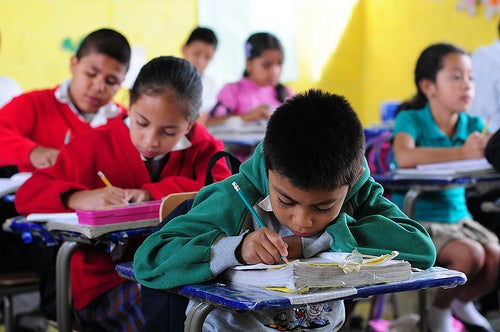
Over the past several decades, developing countries have made remarkable progress in achieving quantitative education targets. Since the turn of the millennium, almost 50 million children around the world have gained access to basic education – and most are reaching completion. But as recent PISA data shows, this is not typically the case for qualitative improvements in education. A persistent learning gap remains for an estimated 250 million children who are unable to read and do math, even after spending three or more years in the classroom.
Education systems reforms are needed in many countries to turn the tide. In a recent article, we propose the following as six necessary components (referred to as the 6A’s) to achieve such reforms:
- Assessment. Benchmarks and benchmark-based assessments are the cornerstone of education planning and reform aiming to improve quality. Countries that are unable to determine where their education system stands currently will find it difficult to make improvements or to reach their goals. One example of success in this area can be found in Jordan, where use of international tests for benchmarking and the use of feedback loops led to impressive gains.
- Autonomy. Empowering schools will determine quality improvements. This includes giving them ownership, resources, and voice while enhancing school competitiveness. Across Australia, Canada, Finland, Japan and Korea – the five OECD countries with both an above-average student performance in science and a below-average impact of socio-economic background on student performance – 80% of 15-year-olds are in schools which report competing with one or more other schools in the area for students. Students in districts with 85% of schools competing with other schools tend to perform better. Autonomy’s potential for transforming education systems depends on whether increased autonomy is accompanied by enhanced accountability mechanisms.
- Accountability. As mentioned, autonomy and accountability are closely related. Accountability increases time on task and academic achievement. As decision-making power is redistributed, local authorities, school principals, teachers, and students are given new responsibilities for resource deployment and school activities. In an autonomy-based structure, school principals are held accountable to municipal authorities for (efficient) use of financial resources. Likewise, school principals are held accountable to both parents and local authorities for improving the learning environment and outcomes.
An accountability-based system usually entails a shift of decision-making authority from the government to the community, which is represented by school governing boards and integrated by teachers, parents, and community members.
In the United Kingdom in 1988, the government gave public secondary schools the option of removing local education authority control and becoming autonomous grant-maintained (GM) schools. GM schools were funded by a new agency but were owned and managed by the school governing body, a new 10-15 member entity composed of the head teacher, as well as teacher and parent representatives. Research finds large achievement gains at schools that voted for GM.
- Attention to teachers. Studies across the world show that a good teacher–one that adds value to the learning process– can be effective in helping students to improve their learning outcomes. The top-performing school systems recruit their teachers from the top third of each graduate cohort: top 5% in South Korea, top 10% in Finland, and top 30% in Singapore and Hong Kong SAR, China. This screening helps to ensure that teachers possess the skills and knowledge necessary to be effective educators. Additionally, in-service training helps teachers to maintain those skills.
- Attention to early childhood development. Early childhood development (ECD) may be the most cost-effective educational investment. Empirical evidence demonstrates that quality ECD interventions increase educational success and adult productivity, and decrease public expenditures later on. A study in Jamaica found that children in a treatment group, whose mothers were taught ways in which to promote cognitive, physical, and emotional development during their child’s early years, earned on average 42% more as young adults than children in the control group who did not receive these benefits.
- Attention to culture. Culture is important and often neglected. The use of the mother tongue as the language of instruction is one cultural area frequently disputed in many countries. For some, the topic has political overtones, for others it can be associated with religious values, and still for others costs are used as an excuse for opposition. In many countries, a significant number of students do not speak the national language in the home, which has practical implications for education. We, and others, have found that schools using mother tongues as the language of instruction have higher attendance and promotion rates, and lower repetition and dropout rates. This trend has specifically been noted in the case of indigenous peoples in Guatemala. Students also better learn their national language by the end of basic education if they first become literate in their mother tongue.
Follow the World Bank education team on Twitter: @WBG_Education




Join the Conversation